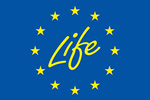ACTION C.1 – (January 2020 – September 2022)
Monitoring and measurements of Environmental Performance Indicators
The aim is the monitoring and measuring of project KPIs to quantify the environmental and socio-economic impact of the project and 5 years after its end. A reference scenario will be compared to an alternative scenario. The reference scenario corresponds to the conventional pig farm without abating technologies, whereas the alternative scenario corresponds to farms where the abating technologies and Nuvap tool will be installed. The impact categories will be calculated both for farms in Italy and in Spain. The following impact categories will be considered: climate change, acidification, eutrophication and particulate matter formation. This action is necessary since a reduction in NH3, PM and GHG is expected in the alternative scenario.
ACTION C.2 – (April 2020 – September 2021)
Monitoring and measurements of animal performance and welfare indicators
C2.1 – Evaluation of the different innovative approaches on performance parameters in pig barns
In fattening farms performance parameters chosen will be: slaughter weight, feed consumption and carcass weight. In farrowing farms reproductive records and piglet weight at weaning will be collected.
C2.2 – Evaluation of the different innovative approaches on welfare indicators in pig barns
For welfare indicators the Welfare Quality protocol will be adopted and adapted for this project. They will be collected in Italy when pigs enter and leave the fattening unit, whereas in Spain on a monthly basis and they will correspond to good health, good housing and appropriate behavior. A multifactorial approach will be used considering for example physiological indicators (immune response) and carcass condemnations due to respiratory problems.
C2.3 – Contribution to RDPs on performance/welfare results
Results will be shared with Operational groups working under Rural Development Programs.
ACTION C.3 – (January 2021 – December 2021)
Life Cycle Assessment/Environmental assessment of the studied solutions for NH₃, GHG, PM and VOCs reduction
The aim is to perform the environmental assessment of the studied solutions for NH₃, GHG, PM and VOCs emission reduction. The LCA approach will be applied. It will be carried out before and after the implementation of the technologies tested. We will compare the baseline scenario to the alternative scenario (the one with abating technologies installed). To perform the LCA analysis, the following steps need to be followed:
- Functional unit and system boundaries definition
- Inventory data collection and establishment of the Life Cycle Inventory
- Impact assessment
- Improvement assessment
The best environmental scenario and the solutions with the highest cost-environmental effectiveness will be identified.
ACTION C.4 – (January 2021 – March 2022)
Socio-economic study
The aim of this action is to perform a socio-economic study to examine how the project will help to improve pig rearing management. The socio-economic analysis will focus not only on the improved sustainability at farm levels, but also how pollutants reduction could improve the economy of rural activities and reduce conflicts with neighborhoods. Moreover, the abating systems will also improve the working environment and the health of the workers. The Social Life Cycle Assessment approach will be used to perform the analysis. Regarding economic benefit for farmers, it will be established considering costs and benefits. Based on the results of the analysis, areas of improvement will be identified.
ACTION C.5 – (January 2021 – June 2022)
Contribution to Technical Reference Documents and policy making
The aim is to contribute to policy making in environmental, agricultural and rural development areas, thus transferring information to organisms directly involved in the development of policies and technical reference documents. A technical report on abatement systems will be produced and submitted to the European IPPC Bureau to be included in BREF document.
C5.1 – Contribution to the Reference Document on Best Available Techniques for Intensive Rearing of Poultry and Pigs
A technical report on the tested abatement systems will be submitted to the European IPPC Bureau in order to evaluate if include them in an updated version of the BREF document.
C5.2 – Contribution to European, national and regional policy making
This action is aimed at contributing to the policy making in the environmental, agricultural and rural development areas.





